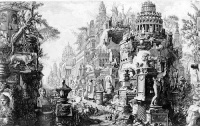Culture as civilization
From The Art and Popular Culture Encyclopedia

Illustration: Antichita Romanae (1748) by Piranesi
|
Related e |
|
Featured: |
- The history of civilization is the history of a long warfare between the dangerous and powerful forces of the id, and the various systems of taboos and inhibitions which man has erected to control them. --Sex in History (1964) -- Gordon Rattray Taylor
Many people today have an idea of "culture" that developed in Europe during the 18th and early 19th centuries. This notion of culture reflected inequalities within European societies, and between European powers and their colonies around the world. It identifies "culture" with "civilization" and contrasts it with "nature." According to this way of thinking, one can classify some countries as more civilized than others, and some people as more cultured than others. Some cultural theorists have thus tried to eliminate popular or mass culture from the definition of culture. Theorists such as Matthew Arnold (1822-1888) or the Leavisites regard culture as simply the result of "the best that has been thought and said in the world” Arnold contrasted mass/popular culture with social chaos or anarchy. On this account, culture links closely with social cultivation: the progressive refinement of human behavior. Arnold consistently uses the word this way: "... culture being a pursuit of our total perfection by means of getting to know, on all the matters which most concern us, the best which has been thought and said in the world".
In practice, culture referred to élite activities such as museum-caliber art and classical music, and the word cultured described people who knew about, and took part in, these activities. These are often called "high culture" to distinguish them from mass culture or popular culture.
From the 19th century onwards, some social critics have accepted this contrast between high and low culture, but have stressed the refinement and of sophistication of high culture as corrupting and unnatural developments that obscure and distort people's essential nature. On this account, folk music (as produced by working-class people) honestly expresses a natural way of life, and classical music seems superficial and decadent. Equally, this view often portrays Indigenous peoples as 'noble savages' living authentic unblemished lives, uncomplicated and uncorrupted by the highly-stratified capitalist systems of the West.
Today most social scientists reject the monadic conception of culture, and the opposition of culture to nature. They recognize non-élites as just as cultured as élites (and non-Westerners as just as civilized) -- simply regarding them as just cultured in a different way. Thus social observers contrast the "high" culture of élites to "popular" or pop culture, meaning goods and activities produced for, and consumed by the masses. (Note that some classifications relegate both high and low cultures to the status of subcultures.)


